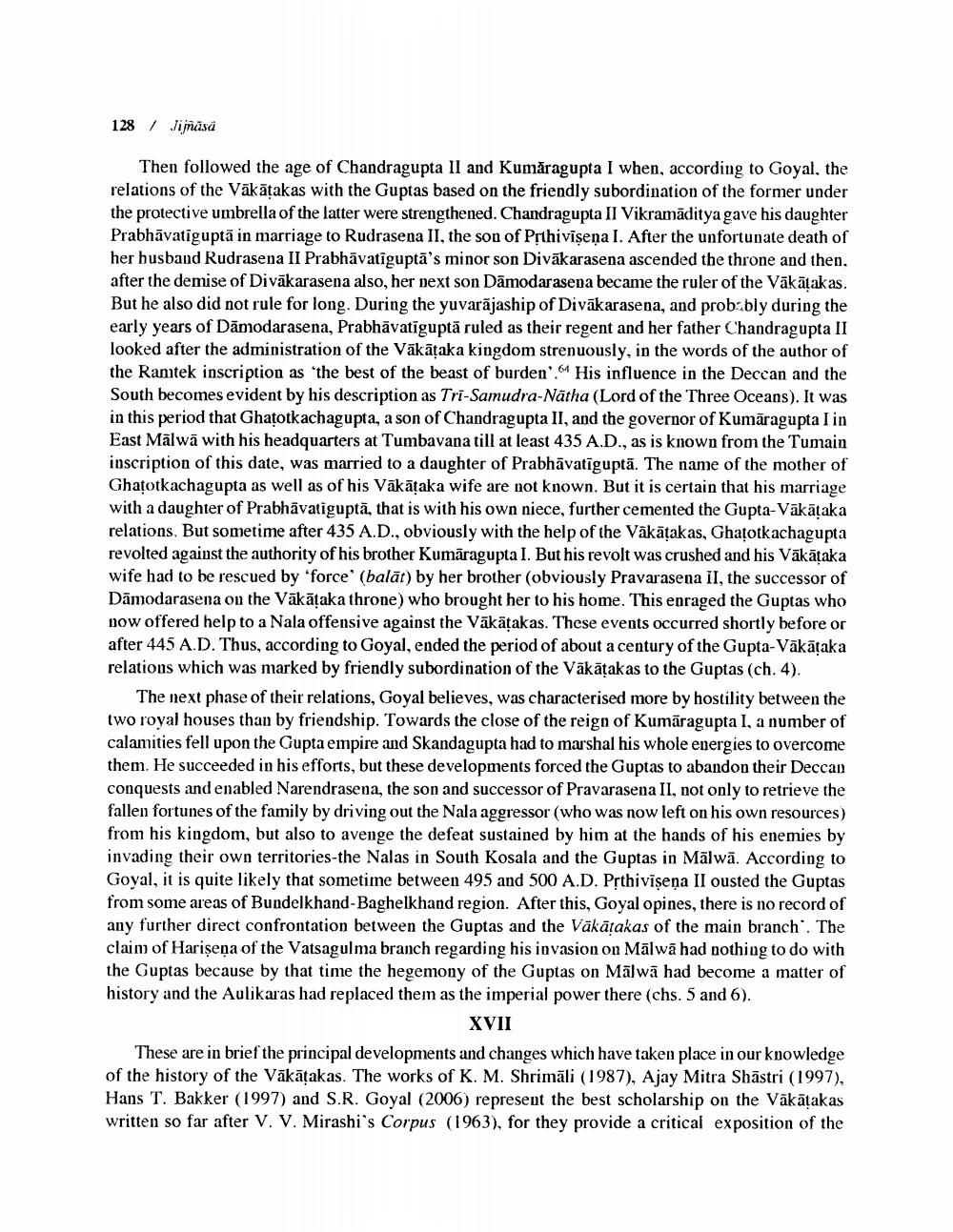________________
128 / Jimasa
Then followed the age of Chandragupta II and Kumăragupta I when, according to Goyal, the relations of the Vākāțakas with the Guptas based on the friendly subordination of the former under the protective umbrella of the latter were strengthened. Chandragupta II Vikramaditya gave his daughter Prabhāvatiguptă in marriage to Rudrasena II, the son of Prthivişeņa I. After the unfortunate death of her husband Rudrasena II Prabhāvatiguptā's minor son Divākarasena ascended the throne and then, after the demise of Divākarasena also, her next son Damodarasena became the ruler of the Vākātakas. But he also did not rule for long. During the yuvarājaship of Divākarasena, and probably during the early years of Damodarasena, Prabhāvatiguptā ruled as their regent and her father Chandragupta II looked after the administration of the Vākāțaka kingdom strenuously, in the words of the author of the Ramtek inscription as the best of the beast of burden'.61 His influence in the Deccan and the South becomes evident by his description as Tri-Samudra-Nātha (Lord of the Three Oceans). It was in this period that Ghatotkachagupta, a son of Chandragupta II, and the governor of Kumāragupta I in East Mālwā with his headquarters at Tumbavana till at least 435 A.D., as is known from the Tumain inscription of this date, was married to a daughter of Prabhāvatiguptă. The name of the mother of Ghatotkachagupta as well as of his Vākātaka wife are not known. But it is certain that his marriage with a daughter of Prabhävatiguptā, that is with his own niece, further cemented the Gupta-Vākātaka relations. But sometime after 435 A.D., obviously with the help of the Vākātakas, Ghatotkachagupta revolted against the authority of his brother Kumāragupta I. But his revolt was crushed and his Väkātaka wife had to be rescued by 'force' (balāt) by her brother (obviously Pravarasena il, the successor of Damodarasena on the Vākāțaka throne) who brought her to his home. This enraged the Guptas who now offered help to a Nala offensive against the Vākāțakas. These events occurred shortly before or after 445 A.D. Thus, according to Goyal, ended the period of about a century of the Gupta-Vākātaka relations which was marked by friendly subordination of the Vākāțak as to the Guptas (ch. 4).
The next phase of their relations, Goyal believes, was characterised more by hostility between the two royal houses than by friendship. Towards the close of the reign of Kumāragupta I, a number of calamities fell upon the Gupta empire and Skandagupta had to marshal his whole energies to overcome them. He succeeded in his efforts, but these developments forced the Guptas to abandon their Deccan conquests and enabled Narendrasena, the son and successor of Pravarasena II, not only to retrieve the fallen fortunes of the family by driving out the Nala aggressor (who was now left on his own resources) from his kingdom, but also to avenge the defeat sustained by him at the hands of his enemies by invading their own territories-the Nalas in South Kosala and the Guptas in Mālwā. According to Goyal, it is quite likely that sometime between 495 and 500 A.D. Pșthivişeņa II ousted the Guptas from some areas of Bundelkhand-Baghelkhand region. After this, Goyal opines, there is no record of any further direct confrontation between the Guptas and the Vākātakas of the main branch. The claim of Harişeņa of the Vatsagulma branch regarding his invasion on Mālwā had nothing to do with the Guptas because by that time the hegemony of the Guptas on Mālwā had become a matter of history and the Aulikaras had replaced them as the imperial power there (chs. 5 and 6).
XVII These are in brief the principal developments and changes which have taken place in our knowledge of the history of the Vākātakas. The works of K. M. Shrimāli (1987), Ajay Mitra Shastri (1997), Hans T. Bakker (1997) and S.R. Goyal (2006) represent the best scholarship on the Vākātakas written so far after V. V. Mirashi's Corpus (1963), for they provide a critical exposition of the




